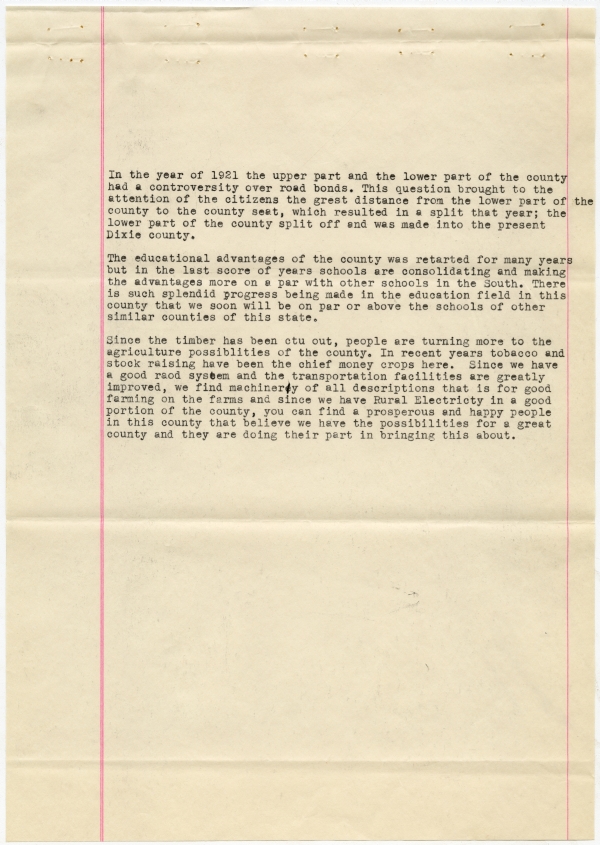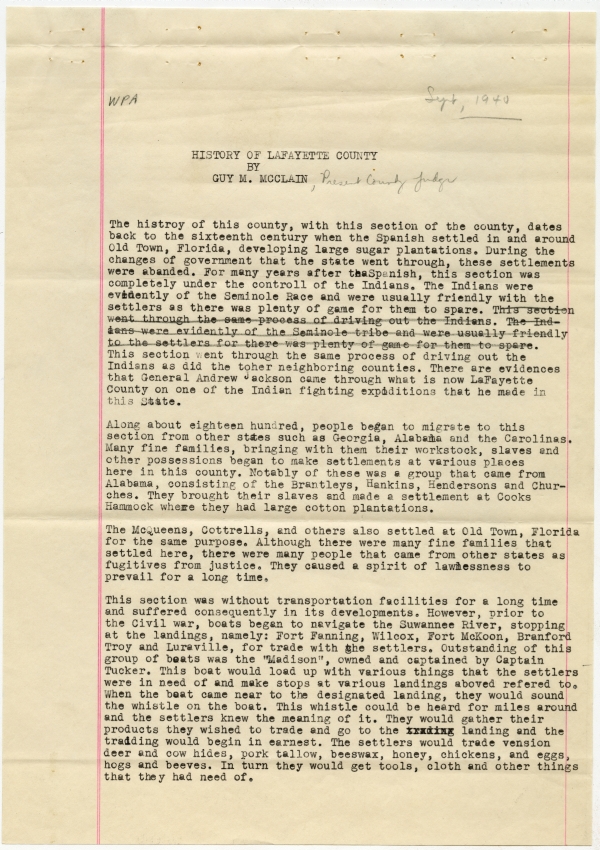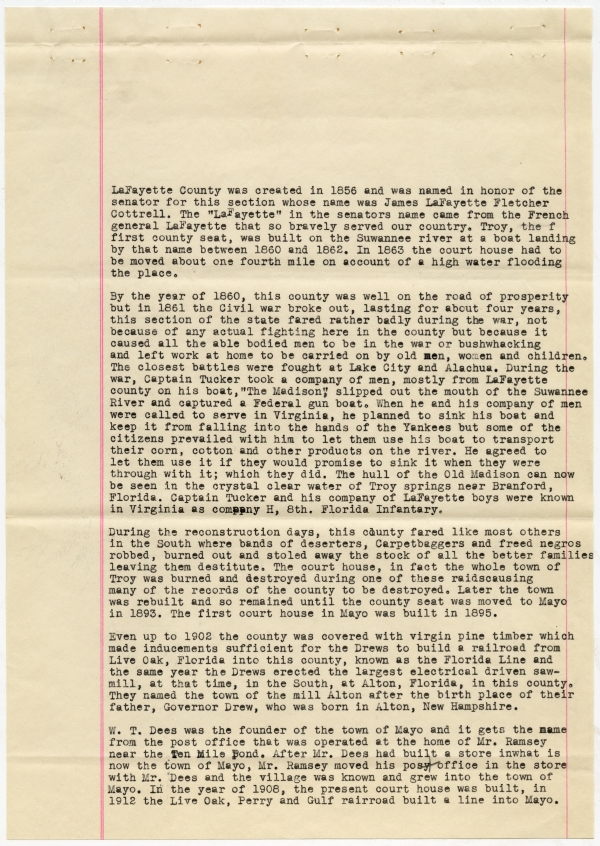WPA
Sept, 1940
HISTORY OF LAFAYETTE COUNTY BY GUY M. MCCLAIN, Present County Judge
The [history] of this county, with this section of the county, dates back to the sixteenth century when the Spanish settled in and around Old Town, Florida, developing large sugar plantations. During the changes of government that the state went through, these settlements were abanded [sic]. For many years after the Spanish, this section was completely under the [control] of the Indians. The Indians were evidently of the Seminole Race and were usually friendly with the settlers as there was plenty of game for them to spare. This section went through the same process of driving out the Indians as did the toher [sic] neighboring counties. There are evidences that General Andrew Jackson came through what is now LaFayette County on one of the Indian Fighting [expeditions] that he made in this State.
Along about eighteen hundred, people began to migrate to this section from other states such as Georgia, Alabama and the Carolinas. Many fine families, bringing with them their workstock, slaves and other possessions began to make settlements at various places here in this county. Notably of these was a group that came from Alabama, consisting of the Brantleys, Hankins, Hendersons and Churches. They brought their slaves and made a settlement at Cooks Hammock where they had large cotton plantations.
The McQueens, Cottrells, and others also settled at Old Town, Florida for the same purpose. Although there were many fine families that settled here, there were many people that came from other states as fugitives from justice. They caused a spirit of lawlessness to prevail for a long time.
This section was without transportation facilities for a long time and suffered consequently in its developments. However, prior to the Civil war, boats began to navigate the Suwannee River, stopping at the landings, namely: Fort Fanning, Wilcox, Fort McKoon, Branford Troy and Luraville, for trade with the settlers. Outstanding of this group of boats was the "Madison", owned and captained by Captain Tucker. This boat would load up with various things that the settlers were in need of and make stops at various landings above refered [sic] to. When the boat came near to the designated landing, they would sound the whistle on the boat. This whistle could be heard for miles around and the settlers knew the meaning of it. They would gather their products they wished to trade and go to the landing and the [trading] would begin in earnest. The settlers would trade [venison] deer and cow hides, pork tallow, beeswax, honey, chickens, and eggs, hogs and beeves. In turn they would get tools, cloth and other things that they had need of.
LaFayette County was created in 1856 and was named in honor of the senator for this section whose name was James LaFayette Fletcher Cottrell. The "LaFayette" in the senators name came from the French general LaFayette that so bravely served our country. Troy, the f [sic] first county seat, was built on the Suwannee river at a boat landing by that name between 1860 and 1862. In 1863 the court house had to be moved about one fourth mile on account of a high water flooding the place.
By the year of 1860, this county was well on the road of prosperity but in 1861 the Civil war broke out, lasting for about four years, this section of the state fared rather badly during the war, not because of any actual fighting here in the county but because it caused all the able bodied men to be in the war or bushwhacking and left work at home to be carried on by old men, women and children. The closest battles were fought at Lake City and Alachua. During the war, Captain Tucker took a company of men, mostly from LaFayette county on his boat, "The Madison", slipped out the mouth of the Suwannee River and captured a Federal gun boat. When he and his company of men were called to serve in Virginia, he planned to sink his boat and keep it from falling into the hands of the Yankees but some of the citizens prevailed with him to let them use his boat to transport their corn, cotton and other products on the river. He agreed to let them use it if they would promise to sink it when they were through with it; which they did. The hull of the Old Madison can now be seen in the crystal clear water of Troy springs near Branford, Florida. Captain Tucker and his company of LaFayette boys were known in Virginia as company H, 8th. Florida [Infantry].
During the reconstruction days, this county fared like most others in the South where bands of deserters, Carpetbaggers and freed negros robbed, burned out and stoled away the stock of all the better families leaving them destitute. The court house, in fact the whole town of Troy was burned and destroyed during one of these raidscausing [sic] many of the records of the county to be destroyed. Later the town was rebuilt and so remained until the county seat was moved to Mayo in 1893. The first court house in Mayo was built in 1895.
Even up to 1902 the county was covered with virgin pine timber which made inducements sufficient for the Drews to build a railroad from Live Oak, Florida into this county, known as the Florida Line and the same year the Drews erected the largest electrical driven sawmill, at that time, in the South, at Alton, Florida, in this county. They named the town of the mill Alton after the birth place of their father, Governor Drew, who was born in Alton, New Hampshire.
W. T. Dees was the founder of the town of Mayo and it gets the name from the post office that was operated at the home of Mr. Ramsey near the Ten Mile Pond. After Mr. Dees had built a store inwhat [sic] is now the town of Mayo, Mr. Ramsey moved his post office in the store with Mr. Dees and the village was known and grew into the town of Mayo. In the year of 1908, the present court house was built, in 1912 the Live Oak, Perry and Gulf [railroad] built a line into Mayo.
In the year of 1921 the upper part and the lower part of the county had a [controversy] over road bonds. This question brought to the attention of the citizens the [great] distance from the lower part of the county to the county seat, which resulted in a split that year; the lower part of the county split off and was made into the present Dixie county.
The educational advantages of the county was retarted [sic] for many years but in the last score of years schools are consolidating and making the advantages more on a par with other schools in the South. There is such splendid progress being made in the education field in this county that we soon will be on par or above the schools of other similar counties of this state.
Since the timber has been [cut] out, people are turning more to the agriculture [possibilities] of the county. In recent years tobacco and stock raising have been the chief money crops here. Since we have a good [road] system and the transportation facilities are greatly improved, we find machinery of all descriptions that is for good farming on the farms and since we have Rural [Electricity] in a good portion of the county, you can find a prosperous and happy people in this county that believe we have the possibilities for a great county and they are doing their part in bringing this about.




 Listen: The Blues Program
Listen: The Blues Program
